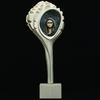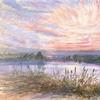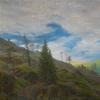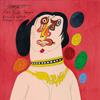Ahead of Major Retrospectives, Take a Look at Sean Scully's Latest Monumental Sculptures in Germany
- July 06, 2020 13:11

The Waldfrieden Sculpture Park in Wuppertal, Germany, is presenting an exhibition entitled INSIDEOUTSIDE, by the Irish artist Sean Scully, through January 3, 2021, and shown across 30 acres of leafy forest land and inside an exhibition space. Scully is world-renowned for his abstract paintings with horizontal and vertical stripes, a motif which he also transfers into three-dimensionality in his monumental sculptures. Exhibited both indoors and outdoors, his towers and stacked works emerge from the ground, made using old railroad sleepers, stainless steel and Corten steel, Murano glass and bronze.

In dialogue with the surrounding landscape, Scully has conceived new site-specific works for Waldfrieden Sculpture Park. Over the course of the exhibition, the artist will create a large-scale work on site using local limestone. A series of sculptures up to five metres high are dotted about the fourteen hectares of verdant woodland, including Sleeper Stack (2019). In September, Scully will paint one of his famous Landline pieces directly onto a glass wall of one of the Sculpture Park’s exhibition pavilions.

In the exhibition pavilion at the highest point of the site, a twelve-part oil painting on copper, 12 Triptychs (2008), will be on display alongside three bronze sculptures.
The beginnings of Scully’s examination of the tension between painting and sculpture in the 1970s are discernible in Grid (1972–2019) in the lower exhibition hall. Scully’s time spent in Morocco and the weavings there have also inspired this work, which evokes the country’s architectural structures and the textures of its carpets. Grid, together with a new, multicoloured stacked sculpture, is shown alongside a large-scale oil painting, What Makes Us (2017). This painting exemplifies the concept of windows as a picture within a picture, an idea Scully has explored since the 1980s. It was this interest that led to his Inset works.

Still influenced by that original concept, Scully has been developing his Holes since the beginning of this year. Round cavities pierce the solid forms of his latest sculptural works and open up to the visitor a view of the surrounding landscape. They establish a connection between “here” and “there”, and at the same time indicate an absence. Scully has expressed the same theme in delicate watercolours, which will also be on display.
Following the Waldfrieden Sculpture Park exhibition, important retrospectives of Scully’s work will be held around the world, including at the Modern Art Museum of Fort Worth in Texas and the Hungarian National Gallery in Budapest.
Sean Scully was born in Dublin in 1945, grew up in London and moved to the United States in 1975. Today, he lives and works in New York and near Munich. He also has a studio in Berlin. Scully studied fine art at the Croydon College of Art in London and at Newcastle University. He was awarded the Frank Knox Fellowship by Harvard University in 1973, the Guggenheim Fellowship in 1983 and has received several honorary degrees, including an Honorary Doctor of Fine Arts from the Massachusetts College of Art in Boston and the National University of Ireland in Dublin. He was nominated twice, in 1989 and 1993, for the Turner Prize, awarded by Tate.





















